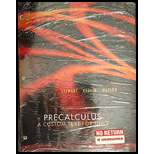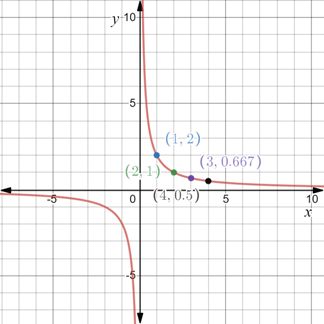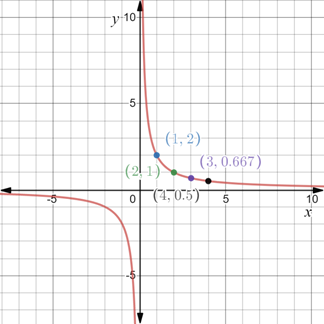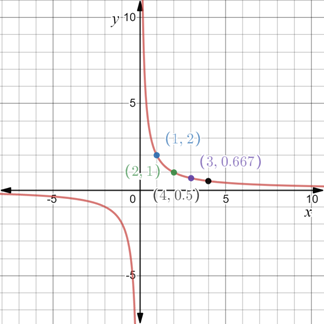
Concept explainers
To calculate: The x- and y- intercepts for the equation
Answer to Problem 67E
There are nox-intercepts and y-intercepts. The equation is symmetric about origin. Graph of the equation is provided below,

Explanation of Solution
Given information:
The equation
Formula used:
The function is symmetric about the x-axis, when y is replaced by
The function is symmetric about the y-axis, when x is replaced by
The function is symmetric with respect to origin, when y is replaced by
The x-intercepts are the points on x-axis where the graph of the equation intersects the x-axis.
The y-intercepts are the points on y-axis where the graph of the equation intersects the y-axis.
Calculation:
It is provided that the equation is
Substitute the point
Substitute the point
Substitute the point
Substitute the point
Construct a table with the values obtained above,
In the coordinate plane plot the points obtained above and connect them through a line.
The graph of the equation is provided below

Recall that the x-intercepts are the points on x-axis where the graph of the equation intersects the x-axis.
Substitute
Therefore, there are no x-intercepts.
Recall that the y-intercepts are the points on x-axis where the graph of the equation intersects the y-axis.
Substitute
Therefore, there are noy-intercepts.
Recall that the function is symmetric about the x-axis, when y is replaced by
Replace y by
The equation is changed. Therefore, the equation
Recall that the function is symmetric about the y-axis, when x is replaced by
Replace x by
The equation is changed. Therefore, the equation
Recall that the function is symmetric with respect to origin, when y is replaced by
Replace x by
The equation is unchanged. Therefore, the equation
Thus, there are nox-intercepts and y-intercepts. The equation is symmetric about origin.Graph of the equation

Chapter 1 Solutions
Precalculus - A Custom Text for UNLV
- Solve the differential equation. 37 6 dy = 2x³y7 - 4x³ dxarrow_forwardFind an equation of the curve that passes through the point (0, 1) and whose slope at (x, y) is 3xy.arrow_forwardQ6. A fossil piece has been found in Alberta that contains 34% of C14 in it. What is the age of this fossil piece?arrow_forward
- Q5. Briefly explain what are isotopes of an elements, with an example, and why some isotopes are radioactive. 470arrow_forwardQ1. Will you earn more interest amount in two years by depositing $2000 in a simple interest account that pays 6% or in an account that pays 6.15% interest compounded monthly? tarrow_forwardQ4. We want to invest $18000 in an account compounded continuously. How long should the investment be kept so final value of the account reaches $25000 if the annual rate of interest is 5.8%?arrow_forward
- Q3. Determine the effective annual yield for each investment below. Then select the better investment. Assume 365 days in a year. a) 5.6% compounded semiannually; b) 5.4% compounded daily.arrow_forwardQ2. You deposit $22,000 in an account that pays 4.8% interest compounded monthly. a. Find the future value after six years. & b b. Determine the effective annual yield of this account.arrow_forward18. Using the method of variation of parameter, a particular solution to y′′ + 16y = 4 sec(4t) isyp(t) = u1(t) cos(4t) + u2(t) sin(4t). Then u2(t) is equal toA. 1 B. t C. ln | sin 4t| D. ln | cos 4t| E. sec(4t)arrow_forward
 Calculus: Early TranscendentalsCalculusISBN:9781285741550Author:James StewartPublisher:Cengage Learning
Calculus: Early TranscendentalsCalculusISBN:9781285741550Author:James StewartPublisher:Cengage Learning Thomas' Calculus (14th Edition)CalculusISBN:9780134438986Author:Joel R. Hass, Christopher E. Heil, Maurice D. WeirPublisher:PEARSON
Thomas' Calculus (14th Edition)CalculusISBN:9780134438986Author:Joel R. Hass, Christopher E. Heil, Maurice D. WeirPublisher:PEARSON Calculus: Early Transcendentals (3rd Edition)CalculusISBN:9780134763644Author:William L. Briggs, Lyle Cochran, Bernard Gillett, Eric SchulzPublisher:PEARSON
Calculus: Early Transcendentals (3rd Edition)CalculusISBN:9780134763644Author:William L. Briggs, Lyle Cochran, Bernard Gillett, Eric SchulzPublisher:PEARSON Calculus: Early TranscendentalsCalculusISBN:9781319050740Author:Jon Rogawski, Colin Adams, Robert FranzosaPublisher:W. H. Freeman
Calculus: Early TranscendentalsCalculusISBN:9781319050740Author:Jon Rogawski, Colin Adams, Robert FranzosaPublisher:W. H. Freeman
 Calculus: Early Transcendental FunctionsCalculusISBN:9781337552516Author:Ron Larson, Bruce H. EdwardsPublisher:Cengage Learning
Calculus: Early Transcendental FunctionsCalculusISBN:9781337552516Author:Ron Larson, Bruce H. EdwardsPublisher:Cengage Learning





